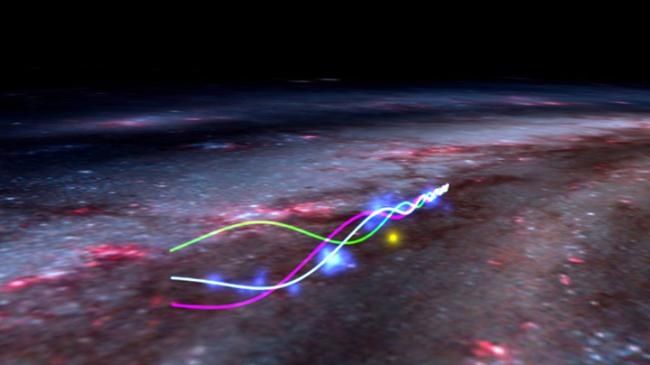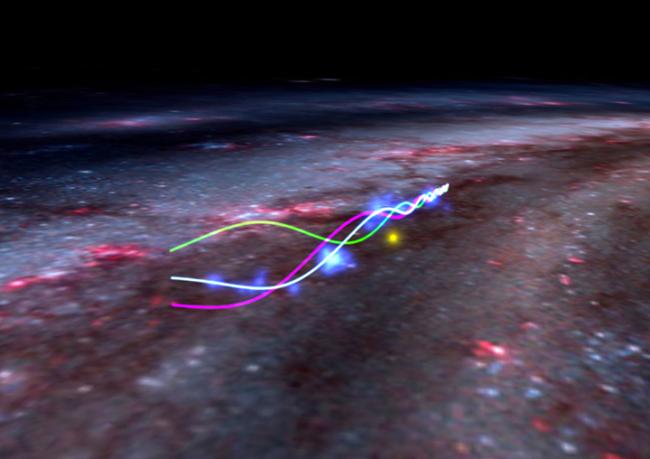Science
Related: About this forumThe Milky Way's enormous, star-studded 'Radcliffe Wave' is literally waving
By Rahul Rao
published February 26, 2024
Scientists realized this massive structure spotted with stars is oscillating over time, gently waving in our galaxy's current.

An illustration of the Radcliffe Wave. (Image credit: Ralf Konietzka, Alyssa Goodman & WorldWide Telescope)
In the Milky Way, not far from our sun, lies a colossal chain of gas clouds. It's called the Radcliffe Wave. Some 800 million stars live within the Radcliffe Wave, and the wave's star-forming gas is even now seeding hundreds of millions more.
As you may imagine, the astronomers who discovered the Wave named it as such because it looked like a "wave" to them — and in a new paper, some of the same astronomers now present evidence that it is also a literal wave. It oscillates over time, they realized, its stars rising through the Milky Way's disk before falling back again.
"By using the motion of baby stars born in the gaseous clouds along the Radcliffe Wave," Ralf Konietzka, a graduate student at Harvard and the paper's lead author, said in a statement, "we can trace the motion of their natal gas to show that the Radcliffe Wave is actually waving."
The Radcliffe Wave is the largest single structure of gas known to astronomy. It is up to 400 light-years deep and 9,000 light-years long, undulating nearly a tenth of the way across the Milky Way's diameter. At its closest to us, the wave is just 500 light-years away. Astronomers discovered it several years ago when they mapped our galaxy's dust.
More:
https://www.space.com/radcliffe-wave-waving-milky-way
~ ~ ~
The Radcliffe Wave is Waving
02.20.24 News Release
CfA astronomers report oscillation of our giant, gaseous neighbor.

Credit: Ralf Konietzka, Alyssa Goodman & WorldWide Telescope
A few years ago, astronomers at the Center for Astrophysics | Harvard & Smithsonian (CfA) uncovered one of the Milky Way's greatest secrets: an enormous, wave-shaped chain of gaseous clouds in our sun’s backyard, giving birth to clusters of stars along the spiral arm of the galaxy we call home.
Naming this astonishing new structure the Radcliffe Wave, in honor of the Harvard Radcliffe Institute where the undulation was originally discovered, astronomers at CfA now report in Nature that the Radcliffe Wave not only looks like a wave, but also moves like one – oscillating through space much like "the wave" moving through a stadium full of fans.
"By using the motion of baby stars born in the gaseous clouds along the Radcliffe Wave," said Ralf Konietzka, the paper's lead author and a Ph.D. student at Harvard’s Kenneth C. Griffin Graduate School of Arts and Sciences and CfA, "we can trace the motion of their natal gas to show that the Radcliffe Wave is actually waving."
. . .
In 2018 when University of Vienna professor João Alves was a fellow at Harvard Radcliffe Institute, he worked with Catherine Zucker – then a Ph.D. student at Harvard and now a Smithsonian Astrophysical Observatory (SAO) astrophysicist at CfA – and Alyssa Goodman, Robert Wheeler Willson Professor of Applied Astronomy at CfA, to map out the 3D positions of the stellar nurseries in the sun’s galactic neighborhood. By combining brand-new data from the European Space Agency's Gaia mission with the data-intensive "3D Dust Mapping" technique – pioneered by Doug Finkbeiner, a Harvard professor at CfA and his team – they noticed a pattern emerging, leading to the discovery of the Radcliffe Wave in 2020.
More:
https://www.cfa.harvard.edu/news/radcliffe-wave-waving
Permanut
(6,636 posts)Thanks Judi Lynn. I hope you haven't found all of it yet.